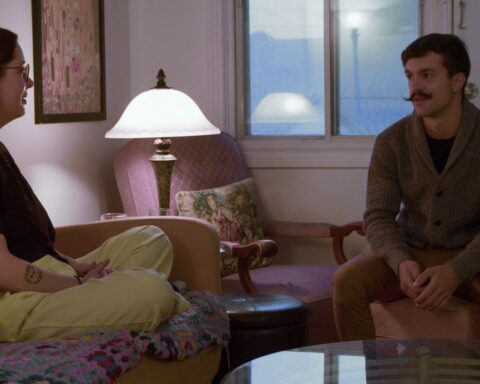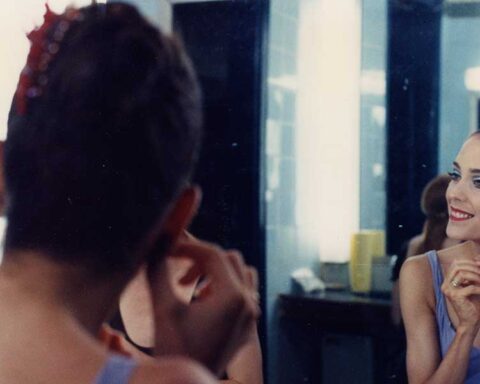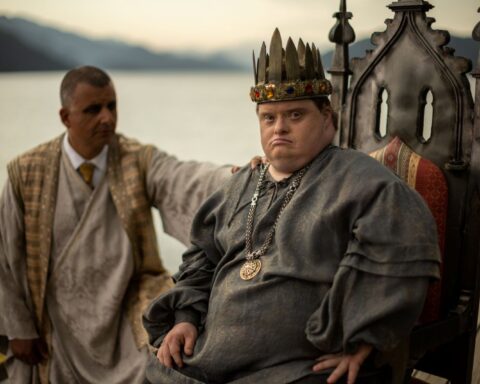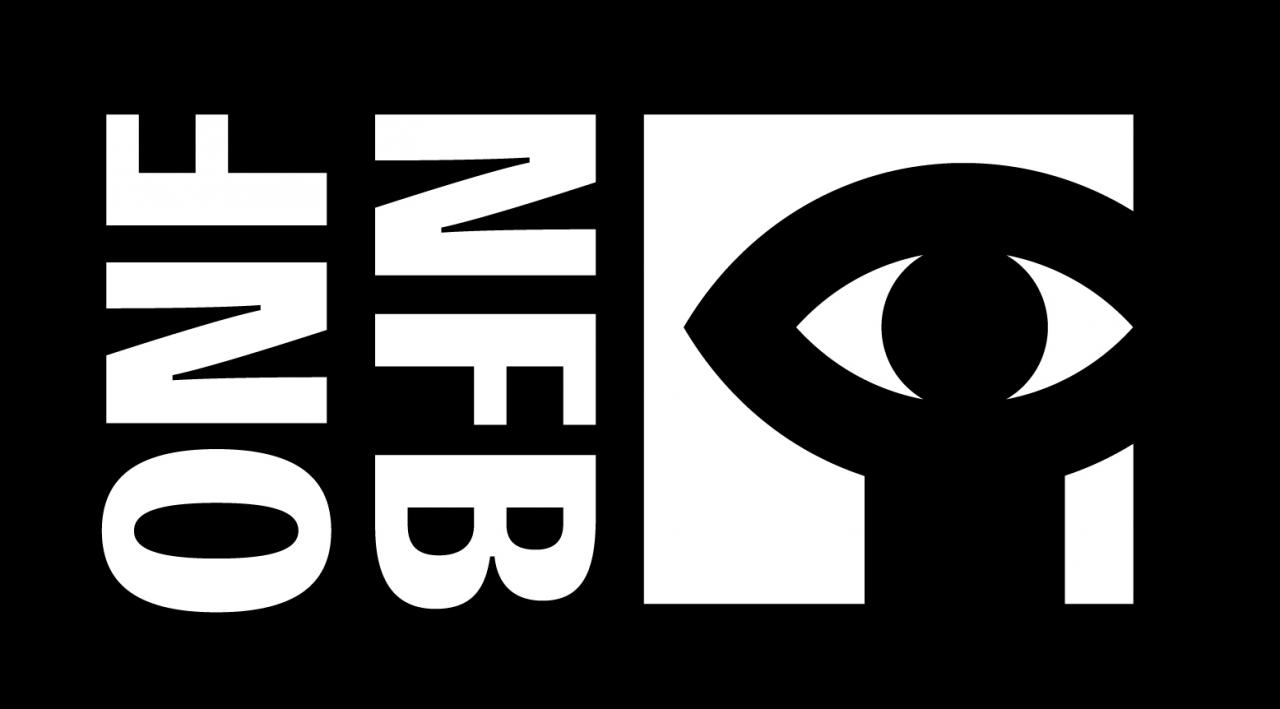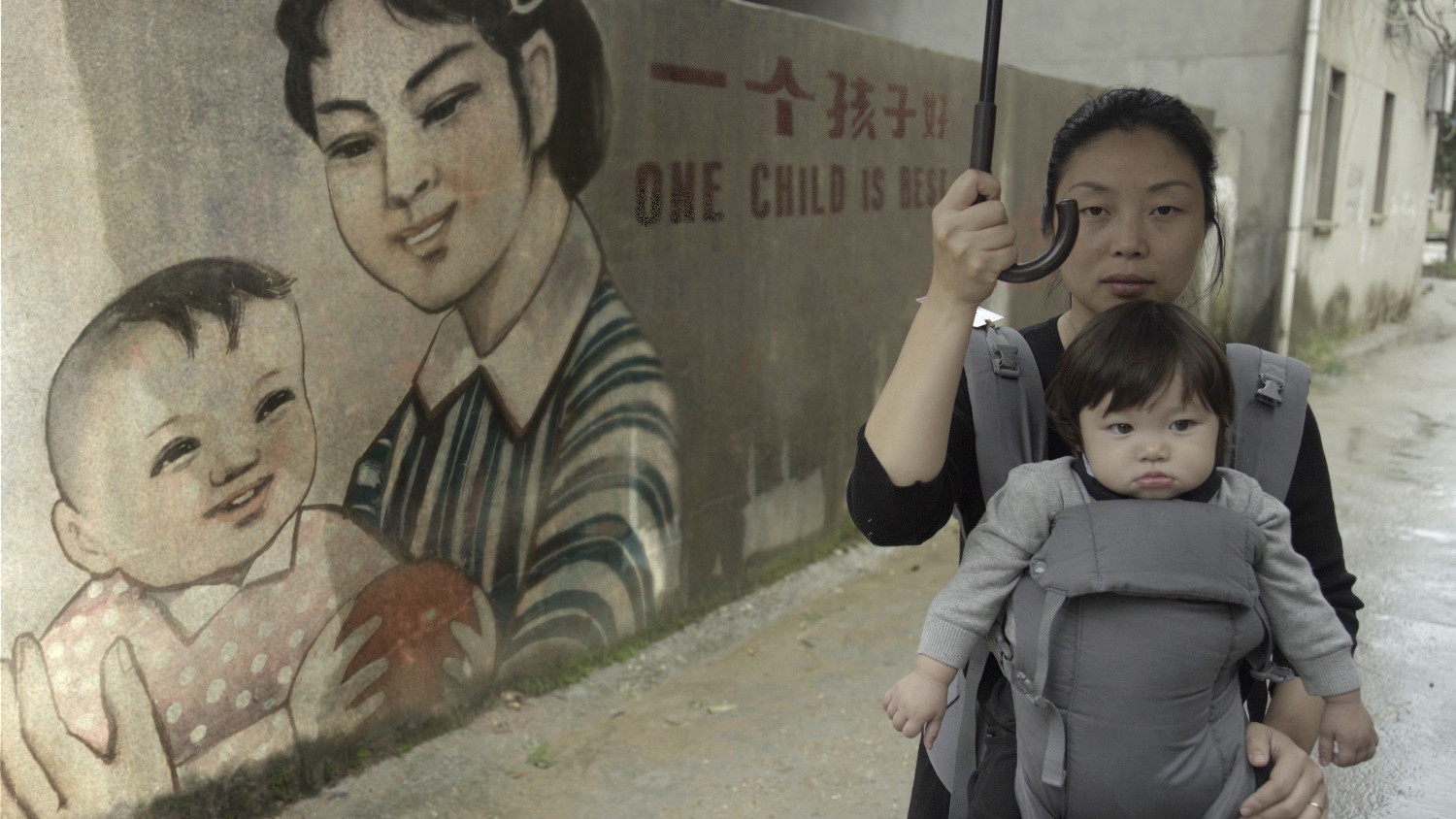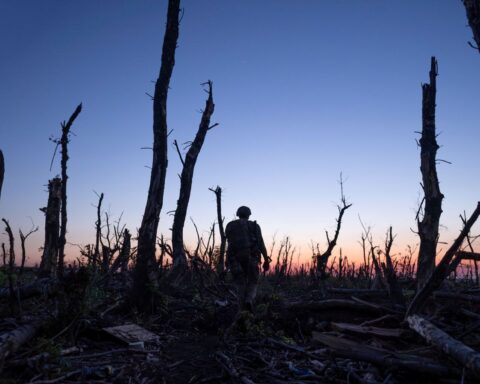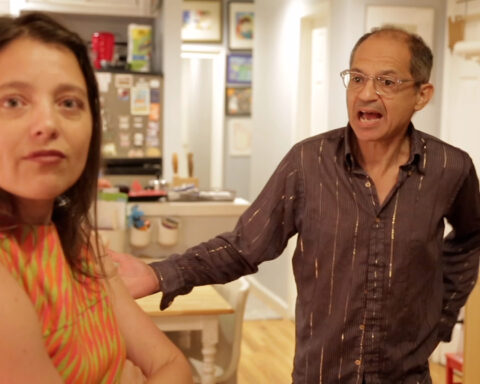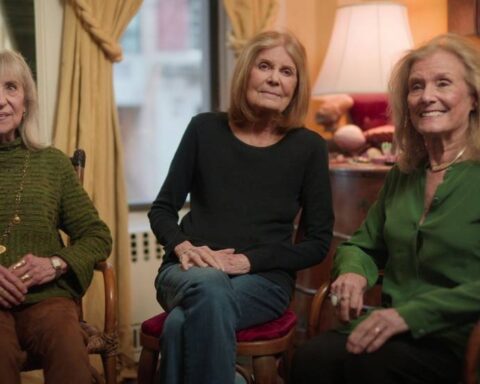To celebrate the eightieth anniversary of the National Film Board of Canada, POV writers have picked 80 films to highlight. These titles are but a mere survey in eight decades of filmmaking that have shaped the nation. (Read Matthew Hays’ introduction to the anniversary here.)
Writers were welcome to select any titles from the NFB catalogue: shorts, features, documentaries, dramas, animation, and interactive/digital works. Some writers included co-productions, while others did not. There are many more films to celebrate and survey, so please join us in looking forward to another 80 years for Canada’s cinematic institution.
Read about the films and watch them below!
Matthew Hays’ Top Ten
Forbidden Love: The Unashamed Stories of Lesbian Lives, Lynne Fernie & Aerlyn Weissman, provided by the National Film Board of Canada
1. Forbidden Love: The Unashamed Stories of Lesbian Lives
(Lynne Fernie and Aerlyn Weissman, 1992)
It’s hard to pinpoint what makes this such an important film, and why it’s such a joy to teach. Filmmakers Lynne Fernie and Aerlyn Weissman use the ostensibly traditional talking-heads strategy to brilliant effect, letting the women in the film tell their sometimes harrowing, always fascinating stories of being queer in a world where being queer was in itself a radical act of survival. The real-life narratives are intercut with dramatic vignettes, an homage to the Sapphic pulp fiction of the 1950s.
If we ever needed the evidence, the age-old stereotype of feminists having little or no sense of humour is blown to smithereens by this doc. Best of all, the women who so bravely faced down such a hostile world refuse to ever become victims, not even for an instant. I screen this film in every class I can, and when I do, the students often cite it as their favourite of the semester, invariably saying the filmmakers succeed in making a film about a very heavy subject that somehow manages to be intensely uplifting.
The fact that Studio D (the NFB’s famous women’s unit, 1974–96) made Forbidden Love is noteworthy for a couple of reasons. Driven primarily by the concerns and issues of second-wave feminists, Studio D had come under fire for taking too long to address queer issues. Forbidden Love ended up being one of the last documentary features that the landmark studio would produce.
2. Neighbours
(Norman McLaren, 1952)
Picasso named this film as his favourite, and one can see why. A gorgeous plea for peace.
3. The Things I Cannot Change
(Tanya Tree, 1967)
Director Tanya Tree, then only 21 years old, made this devastating portrait of poverty, which has become a textbook example of the ethical quandaries of early direct cinema. (The 1984 sequel, Courage to Change, is also well worth revisiting.)
4. Kanehsatake: 270 Years of Resistance
(Alanis Obomsawin, 1993)
Essential viewing, this film remains painfully relevant.
5. If You Love this Planet
(Terre Nash, 1982)
The only thing better than this no-nukes film getting labelled propaganda by the Reagan administration was filmmaker Terre Nash thanking them for handing the film so much free publicity during her Oscar acceptance speech. One of three Studio D films to win an Oscar.
6. Lonely Boy
(Wolf Koenig and Roman Kroitor, 1962)
A wildly prescient film about the culture of celebrity.
7. Very Nice, Very Nice
(Arthur Lipsett, 1961)
Obligatory viewing in any class on montage; a reflection on our terrifying postmodern age.
8. La mémoire des anges
(Luc Bourdon, 2008)
A hypnotic re-imagining and repurposing of NFB/ONF films that brilliantly captures scenes of Montreal. One of the greatest city symphony films ever made.
9. Nobody Waved Good-bye
(Don Owen, 1964)
A bitter portrait of alienated youth, and one of the most important feature films to emerge from the ’60s.
10. The Amina Profile
(Sophie Deraspe, 2015)
A crucial cautionary tale about our strange new online world.
Maya Gallus’ Top Ten
The Company of Strangers, Cynthia Scott, provided by the National Film Board of Canada
1. The Company of Strangers
(Cynthia Scott, 1990)
A small group of women in a field emerge from the mist, walking toward the camera. It’s a gorgeous cinematic image, drawing us into a film that is deceptively simple in its premise—eight women are stranded in the countryside after their bus breaks down—yet profound in its depth and scope.
“Who are these women?” asked Gloria Demers in the original scenario for this hybrid film, variously described as “alternative drama,” “semi-documentary,” or “docu-fiction.” The women, non-actors, play “themselves” in scenes crafted from their own experiences, with much of the dialogue improvised. Writer Mary Meigs, in her memoir In the Company of Strangers, recalls joining the cast of “three English women, a black woman, a Mohawk woman, a Roman Catholic nun…and a French-Canadian of American birth,” painfully aware she is the sole lesbian.
Tentatively, she outs herself onscreen to Cissy Meddings, seventy-six— a memorable moment, paralleled later by another “coming out” as Beth Webber reluctantly reveals her age, eighty, to the only woman under the age of sixty-five, the twenty-seven-year-old bus driver Michelle Sweeny, and then, with even greater reluctance, dramatically removes her wig. And so the film unfolds, a skillful interweaving of documentary and fiction, a meditation on old age, memory, life and death.
The film shimmers with magic, creating an enchanted place, as Meigs writes, “where old women have room to exist.”
2. Stories We Tell
(Sarah Polley, 2012)
Polley brilliantly pushes memoir filmmaking to another level, seamlessly combining documentary footage with recreated home movies, enlisting the complicity of family members and witnesses as potentially unreliable narrators, using the form itself to articulate the elusiveness of truth.
3. Atanarjuat: The Fast Runner
(Zacharias Kunuk, 2001)
Awarded the Caméra d’Or at the Cannes Film Festival, this cinematically gorgeous film was ahead of its time in so many ways—shot on digital video, entirely in Inuktitut, with an Inuit cast, and ninety percent Inuit crew—serving as a powerful rebuttal to what director Kunuk later referred to as “four thousand years of oral history silenced by fifty years of priests, schools, and cable TV.”
4. New Shoes: An Interview in Exactly Five Minutes
(Ann Marie Fleming, 1990)
Juxtaposing lyrical footage and animation with her subject’s matter-of-fact delivery, Fleming stealthily builds tension with inspired touches on the audio track—the hum of a familiar love song, the incessant ticking of a clock—to propel the story to its tragic conclusion.
5. Ryan
(Chris Landreth, 2004)
A visceral, visually stunning, 3-D animated documentary portrait in which the filmmaker honours NFB animator Ryan Larkin, then challenges him to address his demons—which, Landreth acknowledges, parallel his own haunted memories.
6. Forbidden Love: The Unashamed Stories of Lesbian Lives
(Lynne Fernie and Aerlyn Weissman, 1992)
Part of a wave of “New Queer Cinema” in the early ’90s (which largely focused on gay male stories), this hybrid feature is a lesbian classic—a rare chronicle of Sapphic history, illustrated with tongue-in-cheek re-enactments of ’50s pulp fiction.
7. Volcano: An Inquiry Into the Life and Death of Malcolm Lowry
(Donald Brittain and John Kramer, 1976)
This early docufiction on a tragic artist is notable for its inspired use of surreal imagery and Richard Burton’s elegiac readings to evoke a life of self-destruction.
8. Kanehsatake: 270 Years of Resistance
(Alanis Obomsawin, 1993)
A primarily observational documentary that is arguably Abenaki filmmaker Obomsawin’s masterwork. With extraordinary access tovthe frontlines of the Oka Crisis, the result is a sprawling, powerful and compassionate witnessing of dramatic events.
9. Deep Inside Clint Star
(Clint Alberta, 1999)
An unorthodox, highly original narrative about race and sexual identity, in which Métis director Alberta counterpoints the hard aspects of his own and his friends’ stories—alcoholism, depression, incest, abuse and suicide—with an irreverent tone that never belies its poignancy.
10. If You Love this Planet
(Terre Nash, 1982)
Initially denounced as “foreign political propaganda” by US President Reagan, Nash’s Oscar-winning film is a boldly feminist critique of the risks of nuclear war.
Pat Mullen’s Top Ten
Stories We Tell, Sarah Polley, provided by the National Film Board of Canada
1. Stories We Tell
(Sarah Polley, 2012)
There isn’t a better example of the need to tell our own stories than Sarah Polley’s documentary. The deeply personal film, brought to life by Polley’s desire to explore a family secret, meditates on the right one person has to tell another’s story. As Polley digs deeper into her family history, the film interrogates the variations of the truth that arise when memories are fragmented and refracted over time.
Polley pushes the barriers of documentary by running with producer Anita Lee’s suggestion to extend one family’s story to the collective act of storytelling. This shape-shifting plays with notions of truth and fiction—and the presumed authentic truth of documentary—to better understand the story of Sarah’s mother, Diane, and her two fathers, through the perspectives of invested parties and peripheral players.
Atop the layers of interviews and the jovial Margaret Atwood infused narration by Polley’s father Michael, Stories We Tell creates a kaleidoscopic memory game with archival footage and re-enactments seamlessly blended together. Polley’s puzzle challenges our desire for clean-cut narratives, as well as documentary’s presumed authority. More impressive than the film’s formal dexterity and its interplay between truth and fiction, however, is the pure and honest bond of familial love that unites the storytellers as Polley and her family explore a tale that could have easily divided them. Who says all happy families are alike?
2. Kanehsatake: 270 Years of Resistance
(Alanis Obomsawin, 1993)
Obomsawin’s passionate and clear-eyed study of the Oka Crisis is the highlight of perhaps the most illustrious and prolific career at the NFB. It’s an incendiary political film and a landmark of Indigenous self-representation.
3. City of Gold
(Colin Low and Wolf Koenig, 1957)
The filmmakers struck gold in finding archival photographs, including Eric Hegg’s iconic shots of the Chilkoot pass, that form the backbone of this portrait of life in the Yukon. This pioneering film reflects the golden age of the NFB just as much as it does the history of the Gold Rush.
4. If You Love this Planet
(Terre Nash, 1982)
It’s scary how relevant this Oscar winner and precursor to An Inconvenient Truth is over thirty years after it spoke to the horrors of nuclear war. The doc is NFB “propaganda” at its finest.
5. Volcano: An Inquiry Into the Life and Death of Malcolm Lowry (Donald Brittain and John Kramer, 1976)
An engrossing study of author Malcolm Lowry, the all-consuming chaos of his book Under the Volcano and his mysterious death. The film epitomizes the greatness that arises when an artist looks straight into the heat of the inferno while confronting the beast within.
6. Pas de deux
(Norman McLaren, 1968)
One could fill a list of NFB greats with just Norman McLaren films, but this groundbreaking portrait of dancers Margaret Mercier and Vincent Warren, told through layered high-contrast photography, is the best example of his masterful technique and humanist vision.
7. Flamenco at 5:15
(Cynthia Scott, 1983)
This Studio D Oscar winner about a class at the National Ballet School of Canada is a great story of artistic expression and shared experiences. The foot stomps! The fiery energy! The sexy flamenco beats!
8. A Trip Down Memory Lane
(Arthur Lipsett, 1965)
The NFB’s darkly humorous auteur examines human folly and darkness with an ingenious exercise in collage and juxtaposition. If only Lipsett were here to make sense of news footage of Donald Trump!
9. Lipsett Diaries
(Theodore Ushev, 2010)
It seems like bad luck to list a film before it premieres, so instead of Ushev’s latest work, here’s his haunting masterpiece about the troubled mind of Arthur Lipsett—an ingenious fusion of animation and documentary.
10. The Apology
(Tiffany Hsiung, 2016)
As significant as it is heartfelt, The Apology gives voice to three “comfort women” seeking acknowledgment from the Japanese government for horrors committed against them during WWII. Hsiung compassionately asks for the voices of survivors to be heard. [Not currently available to stream.]
Dorothy Woodend’s Top Ten
Cinéma Vérité: Defining the Moment, Peter Wintonick, provided by the National Film Board of Canada
1. Cinéma Vérité: Defining the Moment
(Peter Wintonick, 1999)
In Peter Wintonick’s masterwork Cinéma Vérité, documentarian Wolf Koenig sums it up perfectly: “All documentary is theatre. It’s all manufactured. Every cut is a lie. But you’re telling a lie in order to tell truth.”
Documentary is where it all began for the NFB, as Wintonick’s funny, perambulatory, warts-and-all examination of the art of nonfiction filmmaking makes abundantly clear. The film is more than an introduction to the giants of the genre—Robert Flaherty, Albert Maysles, Robert Drew, Richard Leacock, D.A. Pennebaker, Barbara Kopple, Jean Rouch and Michel Brault, among others.
Accompanied by a glorious bricolage of clips from their work, the filmmakers talk about the genesis of titles such as We Are the Lambeth Boys, The Mills of the Gods, Primary, Jane, and Dont Look Back with a sense of excitement at innovation—the radical thrill of creating something new—that leaps off the screen.
From legendary filmmaker Robert Flaherty, Richard Leacock learned about the “obsession of being there, not of finding out this and analyzing that, or performing some virtuous social act—just what it’s like to be there.”
The NFB was there from the start, helping launch cinéma vérité as a global movement that redefined contemporary cinema. Watching Wintonick’s film again, I feel deeply, proudly and wonderfully Canadian.
The film is also a poignant reminder of the generous spirit of Peter Wintonick himself. His humour, good nature and vast reservoir of knowledge are well in evidence, as is the huge sense of loss in his passing in 2013.
2. What is Democracy?
(Astra Taylor, 2018)
Astra Taylor’s essay film is a call to arms, as well as a powerful reminder that, as Plato said, there is “nothing beautiful without struggle.” In fact, the struggle may be the most important part.
3. Trawna Tuh Belvul
(Martin Rose, 1994)
Earle Birney, animation and trains equal pure Canadian poetry in Martin Rose’s masterpiece.
4. The Company of Strangers
(Cynthia Scott, 1990)
When this documentary-fiction hybrid was released in theatres, I saw it three times in as many weeks. It remains a film to renew one’s faith in humanity.
5. Nails
(Phillip Borsos, 1979)
Borsos finds rough poetry in the ancient art of making nails by hand. The film is mesmerizing, sinuous, and astounding, capturing a century of progress in thirteen minutes.
6. nîpawistamâsowin: We Will Stand Up
(Tasha Hubbard, 2019)
The Cree word nîpawistamâsowin in Hubbard’s brilliant and tragic film translates roughly to the idea of a small group of people standing up for a big group. It’s a fitting description of what filmmakers can do: stand up and speak out so that all Canadians can understand. [Not yet available for streaming.]
7. The Big Snit
(Richard Condie, 1985)
No one who has witnessed Richard Condie’s Scrabble-vs.-nuclear—meltdown masterwork will ever forget the immortal line: “Stop shaking your eyes!”
8. Mighty Jerome
(Charles Officer, 2010)
At one time, Harry Jerome was the fastest man on the planet, holding seven different world titles, including simultaneous world records in both the 100-yard and 100-metre races. This Vancouver hero gets
suitably epic treatment from director Charles Officer. [Available on iTunes.]
9. Crazywater
(Dennis Allen, 2013)
Dennis Allen’s raw exploration of substance abuse among First Nations communities is an incredibly honest effort to speak the truth, beginning with the director’s own story.
10. My Grandmother Ironed the King’s Shirts
(Torill Kove, 1999)
Another gentle reminder that Canadians do animation better than anyone in the world. I’m sure Kove would add, “Especially if they’re Norwegian too!”
Andrew McIntosh’s Top Ten
Begone Dull Care , Evelyn Lambart & Norman McLaren, provided by the National Film Board of Canada
1. Begone Dull Care
(Norman McLaren and Evelyn Lambart, 1949)
Norman McLaren and Evelyn Lambart’s visual representation of three jazz tunes by the Oscar Peterson Trio isn’t just the NFB’s best film by its best filmmaker, it’s one of the greatest films ever made. As thoroughly charming, playful and uplifting as it is abstract and experimental, Begone Dull Care is like a Jackson Pollock painting brought to life by bebop. It’s an energetic, inspiring and invigorating crowd-pleaser that could just as easily play on a loop at the New York Museum of Modern Art—which, of course, it has.
McLaren and Peterson worked together closely over a four-day period to create the music, each finding inspiration in the other’s ideas and improvising freely along the way. McLaren described in his technical notes how “the shaping of the music evolved almost bar by bar, and certainly phrase by phrase,” as he worked out ways to interpret the music through the visuals, which he and Lambart then painted or etched directly onto film stock.
Demonstrating a remarkable understanding of the stylistic and structural parallels between cinema and music, McLaren’s clearly delineated three-act structure mirrors the three-movement structure (exposition, development and recapitulation) of many classical compositions. The film’s central theme of music as a universal language, alluded to by the presentation of titles and credits in eight different languages, echoes McLaren’s ardent sense of internationalism, as well as his lifelong mission to expand on phrasings and expressions within the grammar of cinema.
2. Atanarjuat: The Fast Runner
(Zacharias Kunuk, 2001)
A timeless fable with timely lessons about human nature and the natural world, and still one of the best digitally shot films of all time. [Available on iTunes and on DVD.]
3. Pour la suite du monde
(Pierre Perrault and Michel Brault, 1963)
{The first Canadian feature film to screen at the Cannes Film Festival, Pierre Perrault and Michel Brault’s elegiac, groundbreaking direct cinema documentary boasts stunning imagery and an unmatched rustic elegance.
4. Stories We Tell
(Sarah Polley, 2012)
A meticulously structured postmodern documentary that experiments with film form to question the act of storytelling and the nature of truth.
5. The Sweater
(Sheldon Cohen, 1980)
Classic Canadiana, a lovingly rendered, pitch perfect portrayal of the tension between the country’s original two solitudes.
6. Kanehsatake: 270 Years of Resistance
(Alanis Obomsawin, 1993)
Political theatre at its messiest, and an insightful, indispensable portrait of Canada’s relationship with the Indigenous peoples with whom it shares land.
7. The Champions trilogy
(Donald Brittain, 1978–86)
Political theatre at its finest, and a definitive document of Canada’s constitutional crises of the 1970s and early 1980s.
Stream: Part 1, Part 2, Part 3.
8. Ryan
(Chris Landreth, 2004)
A triumphant mashup of documentary and animation, full of insights into the connections between addiction and the creative mind.
9. The Cat Came Back
(Cordell Barker, 1988)
A Swiss clock of comically calibrated lunacy.
10. Universe
(Roman Kroitor and Colin Low, 1960)
When you’re a key influence on Kubrick’s 2001: A Space Odyssey, the greatest film by one of cinema’s greatest filmmakers, you’re doing something right.
Susan Cole’s Top Ten
1. Pink Ribbons, Inc.
(Léa Pool, 2011)
Check out those pink ribbons on all those professional athletes’ uniforms—even on those football players’ cleats—as they flaunt their support for the campaign to fund cancer research and activism. Surely, we measure progress here. But, actually, no. According to Léa Pool’s riveting film, the Pink Ribbon campaign has been hijacked by corporate sponsors more interested in their bottom lines than in women’s health.
Activism on breast cancer was spawned by women’s anger at the economic system that has allowed cancer-causing products, including cosmetics, to be freely marketed to unknowing consumers and health care professionals, who remained blasé about the epidemic until it was too late. That outrage has morphed into a series of feel-good events, co-opted by sponsors, including Revlon, Ford and even KFC, many of whose products are linked to cancer. Pool’s doc rips into these corporate marauders and the Pink Ribbon organizers who enable them.
Interviews with among others Samantha King, on whose book the doc is based; Barbara Ehrenreich, whose article “Welcome to Cancerland” was also an inspiration; and the late Barbara Brenner of Breast Cancer Action give the doc informational heft. And terrific animated sequences give visual texture to a film that looks spectacular thanks to the way Pool shoots the seas of pink at those mammoth Ribbon events.
Pink Ribbons, Inc. is a key contribution to an essential body of research demonstrating that cancer is now very big business. Cinematic shit-disturbing at its best.
2. Forbidden Love: The Unashamed Stories of Lesbian Lives
(Lynne Fernie and Aerlyn Weissman, 1992)
By cmbining pulp fiction’s lurid depiction of lesbian love with interviews with compelling subjects, this genre-busting documentary—often painful, sometimes very funny—makes visible the pre-second-wave feminist experience of dykes living in a nearly underground world in the ’50s and ’60s.
3. Manufactured Landscapes
(Jennifer Baichwal, 2006)
The first in an influential trilogy mines Edward Burtynsky’s photos evoking human devastation of the planet to terribly beautiful effect—but it’s equally famous for its mindblowing opening tracking shot of Chinese workers at an assembly plant.
4. The Company of Strangers
(Cynthia Scott, 1990)
When their bus breaks down, eight diverse, mainly elderly, women make powerful connections in a film that blurs fiction and reality in groundbreaking ways.
5. Angry Inuk
(Alethea Arnaquq-Baril, 2016)
With help from Tanya Tagaq’s uniquely edgy music and Arnaquq-Baril’s inimitable sense of humour and social media savvy, Angry Inuk takes aim at the racist gaze as it probes the impact of the anti-seal hunt movement on the director’s own Inuit community.
6. Neighbours
(Norman McLaren, 1952)
Two men fight over a flower in this powerhouse Oscar-winning short that set the NFB on the road to becoming the world’s undisputed leader in animation.
7. Life with Murder
(John Kastner, 2009)
This family saga like no other tracks the attempts of parents to cope when their son is accused of murdering his sister. Kastner expertly leaks relevant information about the son’s guilt or innocence in a way that creates an almost perfectly constructed documentary.
8. —
9. Lonely Boy
(Wolf Koenig and Roman Kroitor, 1962)
Training their cameras on teen idol Paul Anka as he performs on tour in this pre-Beatles documentary short, Koenig and Kroitor presage the obsession with celebrities that spawned pop culture and still dominates the media landscape.
10. Ninth Floor
(Mina Shum, 2015)
Shum’s documentary revisits the mainly Black protagonists in the 1969 student uprising over racist practices by a professor at Sir George Williams University. Dominating this compassionate study of activism and reaction is the iconic image of computer cards hurled out of the of the ninth-floor computer centre, slowly drifting to earth.
Judy Wolfe’s Top Ten
1. Angry Inuk
(Alethea Arnaquq-Baril, 2016)
2. The Log Driver’s Waltz
(John Weldon, 1979)
3. Neighbours
(Norman McLaren, 1952)
4. The Big Snit
(Richard Condie, 1985)
5. Kanehsatake: 270 Years of Resistance
(Alanis Obomsawin, 1993)
6. Ryan
(Chris Landreth, 2004)
7. Nails
(Phillip Borsos, 1979)
8. The Sweater
(Sheldon Cohen, 1980)
9. City of Gold
(Colin Low and Wolf Koenig, 1957)
10. Eskimo Artist: Kenojuak
(John Feeney, 1963)
With beauty, charm, intelligence and wit, many NFB films challenge ideas and try to shape the world. My favorite of these is Angry Inuk. Alethea Arnaquq-Baril is proud of her people and how they live and thrive on their land. She is frustrated and angry at those from elsewhere who would deprive them of sustenance and culture. And yet, so Inuk —or,dare I say, so Canadian—she is unfailingly polite when she confronts the enemy.
The NFB has a long history of sending filmmakers to the Arctic. Some of the results are respectful, others less so—sometimes in the same film. Eskimo Artist: Kenojuak is beautifully shot and does a good job of telling us about life on the land and in the studio of a great artist, but John Feeney’s Oscar-nominated film has English narration spoken as if in Kenojuak’s words and voice. More recently, the NFB has enabled Indigenous people to tell their own stories. Instead of people at the “centre” of Canada looking with curiosity at people from the remote edges of the country, Inuit, Abenaki and others are demanding that the people who have taken power away from them pay attention to their reality, their perspective.
Angry Inuk is a highly personal film, in which the filmmaker plays a central role. We see her people, her relationships and her ability to navigate in both the traditional and the modern worlds. The film will succeed in its mission because it is a direct demand from an oppressed yet powerful place: this is our land, this is how we live, we will survive if you respect us.
The entire Canada Vignettes series is worth a look. Who can resist the McGarrigles singing the Log Driver’s Waltz as documentary footage transforms into John Weldon’s lively animation?
The Sweater: Roch Carrier’s story of growing up as a hockey-loving small-town Quebecer and devoted Canadiens fan who is betrayed by his mother’s purchase of a new hockey sweater is animated by Sheldon Cohen and narrated by Carrier himself. It beautifully evokes winter, life centred on radio broadcasts and church, and lessons about the colonial power of the English merchant, Mr. Eaton.
The NFB has had a knack for highlighting absurdity. Neighbours, the Academy Award-winning stop-motion film, and the Oscar-nominated The Big Snit have contributed to our notion of Canadians as people who recognize the futility of many fights. In Neighbours, McLaren and his colleagues demonstrate in eight minutes how quickly greed can replace the joy of shared experience and lead to mutual destruction. Richard Condie takes a different approach in The Big Snit, placing a couple enduring the ordinary irritations of domestic life against a backdrop of nuclear annihilation.
The mirror that NFB filmmakers hold up to Canadians sometimes shows us a picture we might not want to see.
Chris Landreth’s tribute to fellow animator Ryan Larkin, uses advanced technology to look inside the troubled mind of a genius. Kanehsatake, Alanis Obomsawin’s masterpiece, reminds us that our governments, and our military, have been oppressing Indigenous people on their land. Reconciliation has to begin by acknowledging the truth of that oppression.
Finally, I recommend everyone see the technically innovative and beautiful City of Gold — which, in addition to pioneering an effect later made famous by Ken Burns, tells an important story of settlers’ pursuit of wealth at extreme cost—and Nails, which illuminates a manufacturing process that we take for granted.
Marc Glassman’s Top Ten
I’ve chosen to add titles to our survey, showing the depth of the NFB’s output over the years. I love the other selected films—many are masterpieces—but here are ten more that you should see—or see again.
Mon oncle Antoine , Claude Jutra, provided by the National Film Board of Canada
1. Mon oncle Antoine
(Claude Jutra, 1971)
Claude Jutra’s masterpiece about the sudden coming-of-age of Benoît, Antoine’s nephew, in a Quebec mining town “not so many years ago,” bursts alive with a love for its small-town characters. Jutra embraces them all but confers his greatest affection on his leading ensemble, who are quietly etched as individuals with charm and problems: Carmen, the neglected young store-worker, who attracts and rejects Benoît; Fernand, the wry, cunning shop clerk (played with aplomb by Jutra); the lovely and lonely Aunt Cécile; the ever-observant Benoît; and Antoine, the undertaker, shopkeeper and ribald community leader with too great a fondness for gin. With gorgeous shots of winter by ace cinematographer and longtime Jutra associate Michel Brault, the film is a beautifully depicted tale of life and love and death in a Quebec town. It’s a film for the ages, even if Jutra, with his predilections, sadly, was not.
2. Manufacturing Consent
(Mark Achbar and Peter Wintonick, 1992)
This film, subtitled Noam Chomsky and the Media, is an analytical and innovative look at how corporations and governments influence the way news is disseminated. With the growth of social media, opinionated channels like Fox and MSNBC and notions of “fake news” now pervasive, Achbar and Wintonick’s presentation of radical theorist Noam Chomsky’s methodology—essentially to question what any media presents to you—remains crucially relevant today.
3. Lodela
(Philippe Baylaucq, 1996)
This beautifully shot and choreographed dance film depicts the departure of the soul from the body, allowing it to embrace both genders in evocative movements as it joins the afterlife. Only comparable to McLaren’s Pas de deux in the NFB’s oeuvre, Baylaucq’s collaboration with choreographer/dancer José Navas is wildly imaginative and deeply spiritual. A stunning film debut.
4. Window Horses: The Poetic Persian Epiphany of Rosie Ming
(Ann Marie Fleming, 2016)
The fearless, rhapsodic and life-embracing nature of poetry is marvellously distilled in this charming animated feature. In this journey of discovery, a young poet finds herself—and a new home—continents away from Canada in an Iran that is significantly different from the way it’s depicted in the West.
5. Les raquetteurs
(Gilles Groulx and Michel Brault, 1958)
There’s pure joy in this groundbreaking Quebecois direct-cinema depiction of a snowshoeing race in Sherbrooke; watch for the scene when Rocket Richard kisses the homecoming queen.
6. End of the World in Four Seasons
(Paul Driessen, 1995)
A storyboard goes wild as eight connected tales on separate tiny screens powerfully affect each other’s scenarios. Got that? Now imagine these interlocking tales unfolding over the four seasons as Vivaldi’s music plays on.
{7. Why Me?
(Derek Lamb and Janet Perlman, 1978)
When Nesbitt Spoon is told by his doctor that he has five minutes left to live, he rapidly goes through Kubler-Ross’ five stages of grief: denial, anger, bargaining, depression and acceptance. One of the darkest and funniest pieces of animation ever produced.
8. Au chic resto pop
(Tahani Rached, 1991)
A restaurant dedicated to serving the cheapest food to impoverished Montrealers, Chic Resto Pop and its workers star in this innovative documentary-musical, with rock, blues and rap used to express the radical populism underpinning this eatery.
9. The Kid Who Couldn’t Miss
(Paul Cowan, 1982)
This dark and funny profile of WWI pilot Billy Bishop was investigated by the Senate for daring to doubt one of Canada’s heroes. A musical-documentary hybrid and a truly high-spirited film.
10. Paper Wheat
(Albert Kish, 1979)
This film about a play, which dramatized the growth of the Saskatchewan Wheat Pool collective, belies its niche description and becomes a delightful evocation of the early days of Canada’s prairie life.





